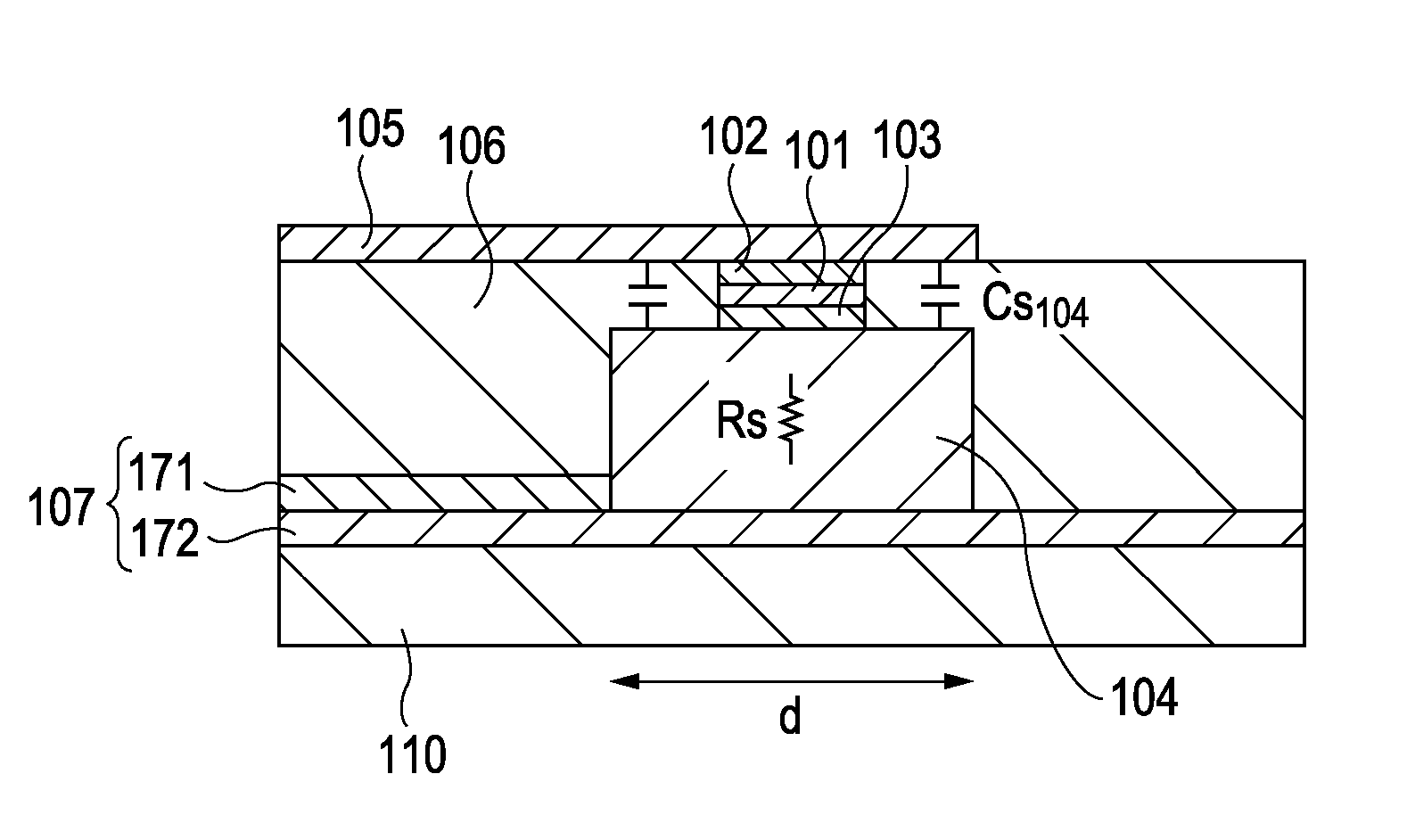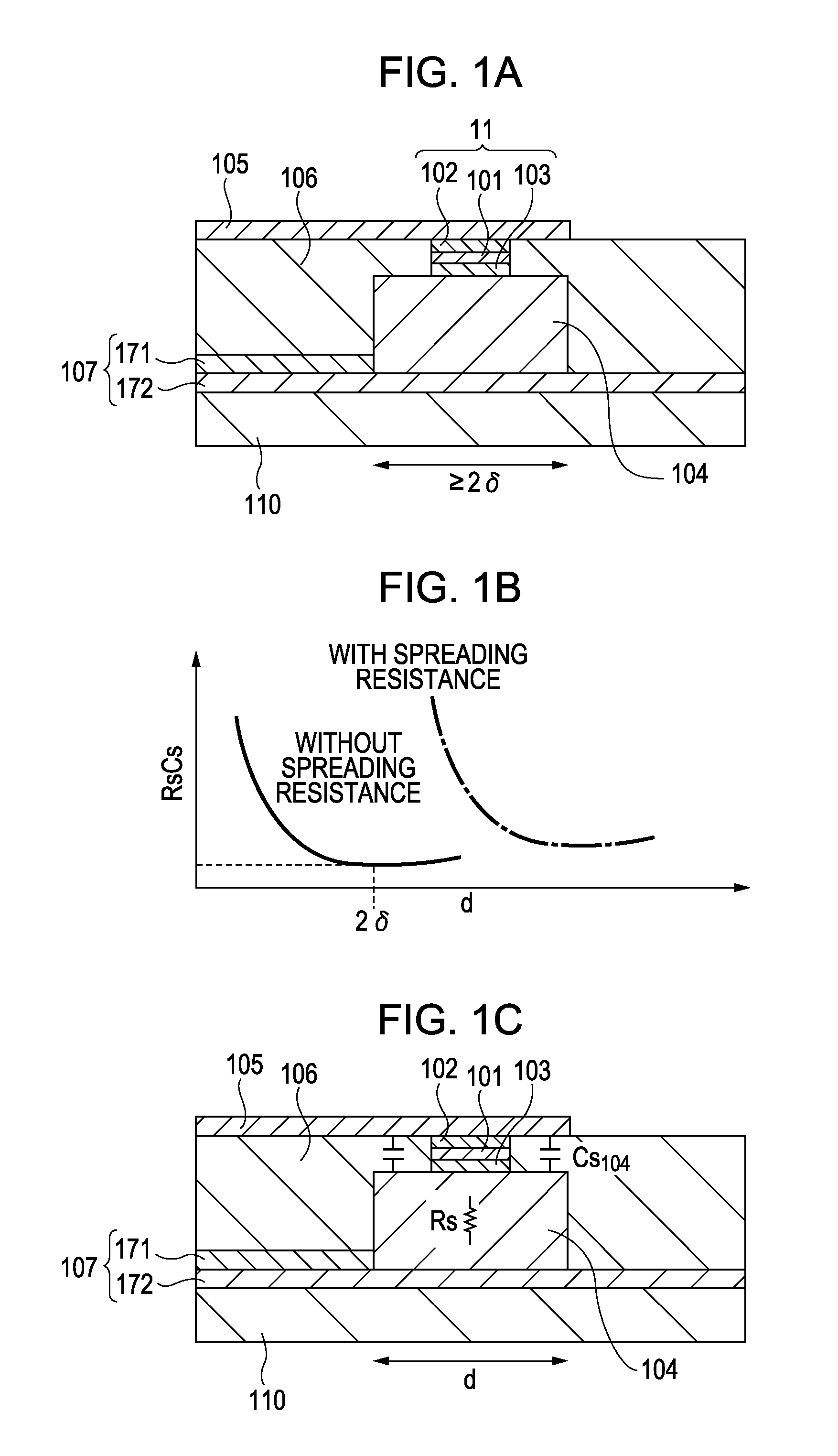Resonator
a resonator and diode technology, applied in the field of resonators, can solve the problems of limiting the configuration of the resonator to achieve impedance matching, the thickness and/or the material of the dielectric included in the resonator, and the difficulty of selecting the thickness and/or the material of the resonator, so as to minimize the delay time, reduce the stray capacitance, and minimize the series resistance of the resonant tunneling di
- Summary
- Abstract
- Description
- Claims
- Application Information
AI Technical Summary
Benefits of technology
Problems solved by technology
Method used
Image
Examples
first embodiment
[0038]A resonator according to a first embodiment of the present invention will be described with reference to FIGS. 1A, 1B, and 1C. FIG. 1A shows a sectional view of the resonator of the first embodiment.
[0039]An RTD according to the first embodiment includes a resonant tunneling structure layer 101, the electrical contact layers 102 and 103 (first and second electrical contact layers 102 and 103) that are provided to apply a current to the resonant tunneling structure layer 101, and a resistor layer 104. The resonator of the first embodiment is sandwiched between two conductors 105 and 107 that are opposed to each other (first and second conductors 105 and 107). The resonant tunneling structure layer 101 is connected to a grounded metal 171 via a metal contact layer 172, and the conductor 107 (the grounded metal 171 and the grounded metal layer 172) doubles as a common electrode provided for a direct current (DC) and an alternating current (AC). Here, the conductor 105 (first cond...
second embodiment
a
[0048]A resonator according to a second embodiment of the present invention will be described with reference to FIGS. 2A, 2B, and 2C. FIG. 2A is the top plan view of the resonator of the above-described embodiment and FIG. 2B is the sectional view of the resonator of the above-described embodiment.
[0049]The resonator of the above-described embodiment includes a patch antenna known as a microstrip antenna. The patch antenna is a distributed constant resonator (a resonator having a structure which is approximately as large as the resonant wavelength) and the resonance frequency thereof is determined based on the in-plane length of a patch antenna 251. Usually, a λ / 2 patch antenna is used. An electromagnetic wave emitted from a resonant tunneling diode is caused to resonate with the patch antenna, and oscillates. Then, the electromagnetic wave can be taken outside through the use of the load on the patch antenna 251. Here, the specification of the load on the patch antenna 251 is dete...
third embodiment
r
[0052]A resonator according to a third embodiment of the present invention will be described with reference to FIGS. 3A and 3B. FIG. 3A is a top plan view of the resonator of the above-described embodiment and FIG. 3B is a sectional view of the resonator of the above-described embodiment.
[0053]The resonator of the above-described embodiment includes a coupled-line filter known as a microstrip filter. The coupled-line filter is a distributed constant resonator and the resonance frequency thereof (specified frequency) is determined based on the in-plane length of a microstrip-line resonator 351. Usually, a λ / 2 microstrip line is used. Further, two microstrip lines 308 are provided to have a magnetic field coupling with the λ / 2 microstrip line. An electromagnetic wave emitted from a resonant tunneling diode is injection-synchronized with an electromagnetic wave transmitted to one of the microstrip lines 308 and oscillates. In this manner, an electromagnetic wave with an amplitude larg...
PUM
 Login to View More
Login to View More Abstract
Description
Claims
Application Information
 Login to View More
Login to View More - R&D
- Intellectual Property
- Life Sciences
- Materials
- Tech Scout
- Unparalleled Data Quality
- Higher Quality Content
- 60% Fewer Hallucinations
Browse by: Latest US Patents, China's latest patents, Technical Efficacy Thesaurus, Application Domain, Technology Topic, Popular Technical Reports.
© 2025 PatSnap. All rights reserved.Legal|Privacy policy|Modern Slavery Act Transparency Statement|Sitemap|About US| Contact US: help@patsnap.com



